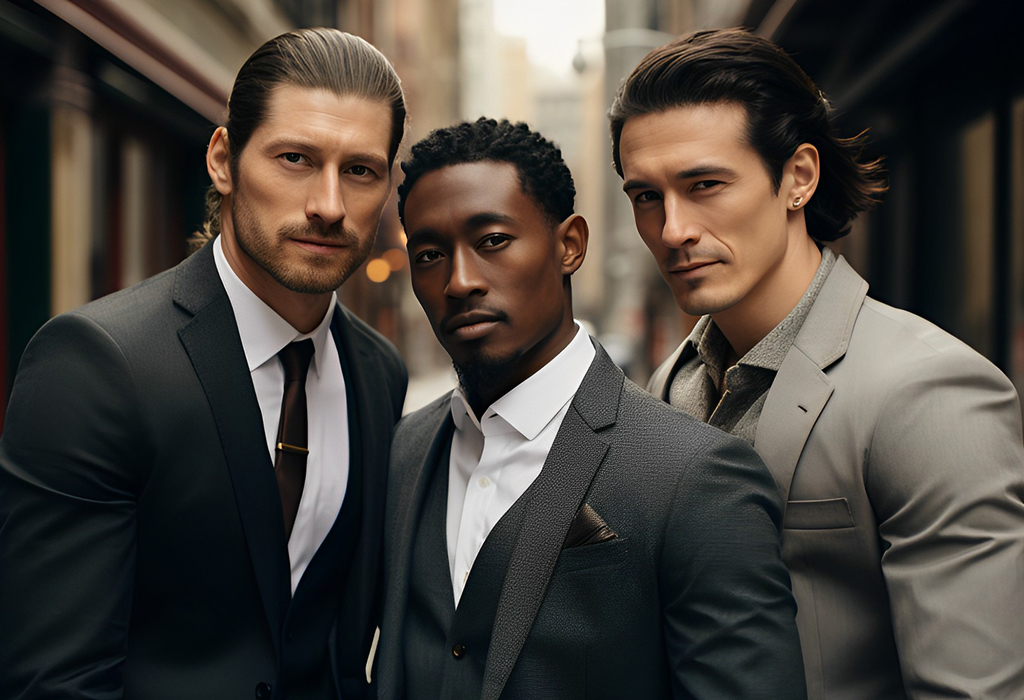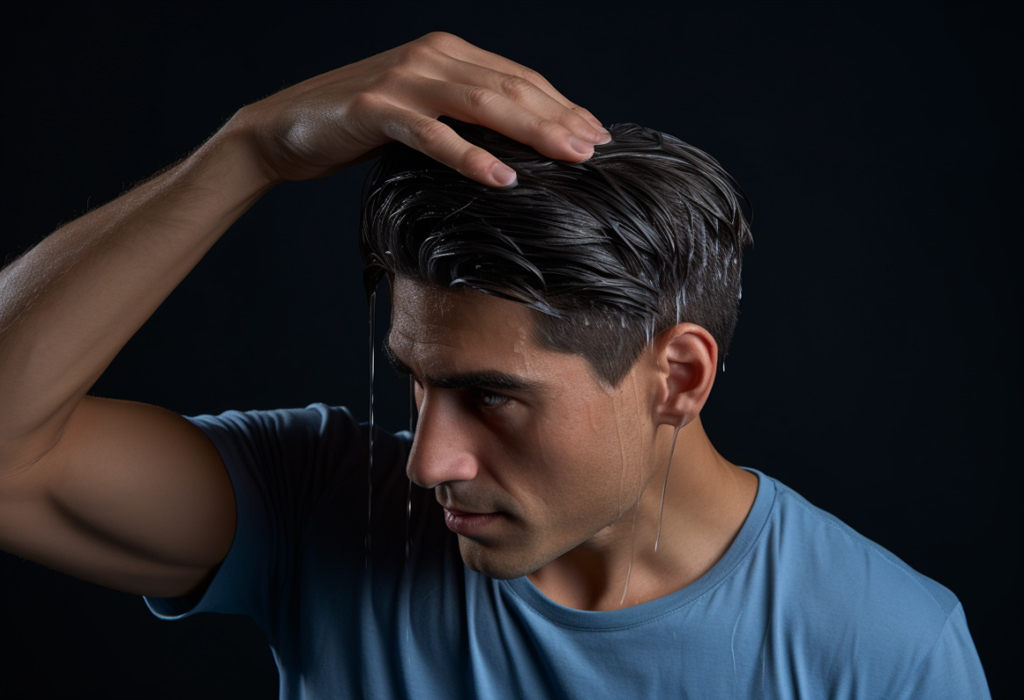

Are you looking to up your hair game?
Whether you’re sporting straight locks, wavy tresses, or tight coils, understanding your hair type and choosing the right products can make all the difference.
In this guide we’ll be covering everything from identifying your hair type to selecting the perfect styling products and mastering care routines.
What Are Different Hair Types?
First things first: identifying your hair type is crucial for proper care and styling. Hair types are generally categorized into four main groups:
- Type 1: Straight Hair
- Type 2: Wavy Hair
- Type 3: Curly Hair
- Type 4: Coily/Kinky Hair
Each hair type has its own characteristics and care requirements. So let’s break them down further:
Type 1 – Straight Hair


Straight hair falls flat from the roots to the ends with no curls or waves. It’s often shiny due to the even distribution of natural oils. There are three subtypes:
- 1A: Very straight, fine, and thin
- 1B: Straight with a bit more volume
- 1C: Straight with body and volume, may have a slight wave
Straight hair is prone to oiliness but is generally easy to manage and style. It’s common among Asian, some Caucasian, and Native American men.
Type 2 – Wavy Hair


Wavy hair forms an “S” shape and tends to be less shiny than straight hair with slight frizz. Subtypes include:
- 2A: Loose, tousled waves
- 2B: More defined S-shaped waves
- 2C: Thick, coarse waves with some frizz
Wavy hair is versatile for styling but can be prone to frizz and dryness. It’s common among Caucasian, Latino, and some Middle Eastern men.
Type 3 – Curly Hair


Curly hair has defined curls that are springy and bouncy. It can be prone to dryness and frizz. Subtypes are:
- 3A: Large, loose curls
- 3B: Tighter, springy curls
- 3C: Tight, corkscrew curls
Curly hair requires regular moisturizing and tends to shrink when dry. It’s common among African American, Latino, Middle Eastern, and some Caucasian men.
Type 4 – Coily/Kinky Hair


Coily hair has tightly coiled or zig-zag patterns and is very prone to dryness and shrinkage. Subtypes include:
- 4A: Soft, defined, tightly coiled curls
- 4B: Z-pattern curls, less defined
- 4C: Very tight, almost zig-zag pattern with minimal definition
Coily hair requires intensive moisturizing and care. It’s most common among African and African American men.
How to Identify Your Hair Type
Determining your hair type is a crucial step in developing an effective hair care routine. We recommend following steps to help you identify your hair type:
- Wash and Air Dry: Start with clean hair, free from any styling products. Wash your hair with a gentle shampoo and conditioner, then allow it to air dry completely without using any additional products or heat styling tools. This will reveal your hair’s natural texture and pattern.
2. Examine the Curl Pattern: Once your hair is dry, take a close look at its natural form:
- Straight hair will fall flat with no curls or waves.
- Wavy hair will have a distinct “S” shape.
- Curly hair will form tight curls or ringlets.
- Coily hair will have tight coils or a zig-zag pattern.
3. Assess Texture and Thickness: Gently feel a strand of your hair between your fingers:
- Fine hair feels thin and soft, almost slipping through your fingers.
- Medium hair feels thicker and has more body.
- Coarse hair feels thick and rough.
4. Consider Density: Look at your scalp in a mirror or take a picture:
- Low density: You can easily see your scalp without parting your hair.
- Medium density: You can see your scalp when you part your hair.
- High density: It’s difficult to see your scalp even when parting your hair.
5. Observe Porosity: This refers to your hair’s ability to absorb and retain moisture:
- Low porosity: Hair floats on water and takes time to get wet.
- Medium porosity: Hair absorbs water at a moderate rate.
- High porosity: Hair sinks quickly and absorbs water easily but also loses it quickly.
6. Consider Ethnicity: While not definitive, your ethnic background can provide clues about your likely hair type. However, remember that there’s significant variation within ethnic groups, and many people have mixed heritage.
7. Analyze Your Hair’s Behavior: Pay attention to how your hair reacts in different conditions:
- Does it frizz easily in humidity?
- How quickly does it get oily after washing?
- Does it tangle easily?
- How does it respond to different styling products?
Your hair might not fit perfectly into one category. Many people have combination hair types or fall between categories. The key is to understand your hair’s unique characteristics so you can care for it properly.
Care Tips for Each Hair Type


Now that you’ve identified your hair type, let’s dive into specific care tips for each:
Straight Hair (Type 1):
- Use lightweight shampoos and conditioners to avoid weighing down your hair.
- Combat oiliness by washing your hair regularly, but be careful not to over-wash, which can stimulate more oil production.
- Use dry shampoo between washes to absorb excess oil.
- Avoid heavy styling products that can make your hair look greasy.
- To add volume, try using a volumizing mousse or spray at the roots before blow-drying.
- Regular trims are essential to prevent split ends, which are more noticeable in straight hair.
Wavy Hair (Type 2):
- Focus on frizz control and hydration. Look for products that provide moisture without weighing down your waves.
- Use a sulfate-free shampoo to prevent stripping natural oils.
- Apply a leave-in conditioner to damp hair to enhance wave definition.
- Scrunch your hair while it’s damp to encourage wave formation.
- Use a diffuser attachment when blow-drying to maintain wave pattern and reduce frizz.
- Consider the “plopping” technique: wrapping damp hair in a microfiber towel or t-shirt to enhance waves.
- Avoid brushing dry hair, as this can cause frizz. Instead, use your fingers or a wide-tooth comb.
Curly Hair (Type 3):
- Opt for sulfate-free, moisturizing shampoos and conditioners.
- Deep condition regularly to maintain moisture and elasticity.
- Use the “squish to condish” method: applying conditioner and scrunching it into your hair while it’s soaking wet.
- Apply styling products to soaking wet hair to lock in moisture and enhance curl definition.
- Try the “prayer hands” technique: smoothing products over your hair with flat hands to distribute evenly.
- Avoid heat styling when possible. If you must use heat, always apply a heat protectant first.
- Sleep on a satin or silk pillowcase to reduce frizz and maintain curl shape.
- Refresh curls between washes with a water-based spray and light scrunching.
Coily Hair (Type 4):
- Use deeply moisturizing, sulfate-free shampoos and conditioners.
- Incorporate regular deep conditioning treatments, possibly with heat for better penetration.
- Consider the “LOC” (Liquid, Oil, Cream) or “LCO” (Liquid, Cream, Oil) method for maximum moisturization.
- Use leave-in conditioners and curl creams to keep hair hydrated throughout the day.
- Apply oils and butters to seal in moisture and provide shine.
- Detangle gently with your fingers or a wide-tooth comb, starting from the ends and working up to the roots.
- Protect your hair at night with a satin or silk bonnet or pillowcase.
- Consider protective styles like braids or twists to minimize manipulation and retain moisture.
- Trim regularly to prevent split ends from traveling up the hair shaft.
Choosing The Right Hair Products
With countless options available, selecting the right hair product can be overwhelming. Here’s an expanded guide to some popular choices:
Pomade:
- Best for: Slick, glossy styles; works well for straight and wavy hair.
- Hold: Medium to strong
- Shine: High (oil-based) or medium (water-based)
- Application: Work a small amount through damp or dry hair.
- Tips: Oil-based pomades provide more shine but are harder to wash out. Water-based options are easier to clean but may provide slightly less hold.
Fiber:
- Best for: Adding thickness and texture; ideal for short to medium wavy and curly hair.
- Hold: Strong
- Shine: Low
- Application: Rub between palms and apply to dry hair.
- Tips: Great for creating messy, tousled looks. A little goes a long way.
Clay:
- Best for: Adding texture and volume; suitable for all hair types, especially thick and wavy hair.
- Hold: Medium to strong
- Shine: Matte
- Application: Warm between palms and apply to damp or dry hair.
- Tips: Provides a natural, gritty texture. Can help absorb excess oil.
Gel:
- Best for: Structured, wet looks; works for all hair types.
- Hold: Strong
- Shine: High
- Application: Apply to damp hair and style as desired.
- Tips: Can cause flaking if too much is used. Look for alcohol-free options to prevent drying.
Wax:
- Best for: Flexible, textured looks; ideal for short to medium straight and wavy hair.
- Hold: Medium to strong
- Shine: Medium
- Application: Warm between palms and apply to dry hair.
- Tips: Provides reworkable hold throughout the day.
Cream:
- Best for: Natural, flowy styles; suitable for all hair types, especially longer hair.
- Hold: Light to medium
- Shine: Low to medium
- Application: Apply to damp or dry hair.
- Tips: Great for adding light control and shine without weighing hair down.
Sea Salt Spray:
- Best for: Beachy, tousled styles; ideal for wavy and curly hair.
- Hold: Light
- Shine: Matte
- Application: Spray on damp hair and scrunch or air dry.
- Tips: Can be drying, so use in moderation and follow up with a leave-in conditioner if needed.
Mousse:
- Best for: Adding volume and body; ideal for fine and straight hair.
- Hold: Light to medium
- Shine: Low to medium
- Application: Apply to damp hair, focusing on roots for volume.
- Tips: Great for creating lift and fullness without heaviness.
Hair Oil:
- Best for: Adding shine and smoothness; ideal for dry, frizzy, or damaged hair.
- Hold: None
- Shine: High
- Application: Apply a small amount to damp or dry hair, focusing on ends.
- Tips: A little goes a long way. Can be used as a pre-shampoo treatment for extra moisture.
Texture Powder:
- Best for: Adding volume and texture; ideal for fine to medium hair.
- Hold: Light
- Shine: Matte
- Application: Sprinkle directly onto roots or areas needing volume.
- Tips: Great for refreshing second-day hair and adding lift at the roots.
Styling Tips and Tricks
Mastering the art of hair styling takes practice, but these tips will help you get started:
- Start with Clean Hair: Most styling products work best on clean, slightly damp hair. This provides a blank canvas for your style.
- Know Your Products: Understand how different products interact. For example, layering a water-based product over an oil-based one can cause flaking.
- Less is More: Start with a small amount of product and add more if needed. It’s easier to add than to remove excess.
- Distribution is Key: Ensure even distribution of product by rubbing it between your palms before applying, and work it through your hair from roots to tips.
- Experiment with Application Techniques: Try applying product to damp vs. dry hair, or experiment with different application methods (scrunching, raking, praying hands) to see what works best for your hair.
- Invest in Quality Tools: Good brushes and combs can make a significant difference in your styling results. Consider:
- Wide-tooth comb for detangling
- Boar bristle brush for smoothing and distributing natural oils
- Round brush for adding volume when blow-drying
- Master the Blow-Dry: Learning to properly blow-dry your hair can dramatically improve your style:
- Use a heat protectant spray
- Start with roots and work your way down
- Point the nozzle downward to smooth the hair cuticle
- Use a cool shot at the end to set your style
- Embrace Air-Drying: For a more natural look or to minimize heat damage, try air-drying techniques:
- Scrunch waves or curls with a microfiber towel
- Use hair clips to create volume at the roots while drying
- Twist sections of hair for more defined waves
- Night-Time Routine: Protect your style while you sleep:
- Use a silk or satin pillowcase to reduce friction
- Try “pineappling” (loosely tying hair at the crown) for curly hair
- Use a leave-in conditioner or light oil on ends to prevent dryness
- Touch-Up Techniques: Learn how to refresh your style between washes:
- Use dry shampoo for oily roots
- Dampen and re-scrunch curls with a water-based spray
- Keep a small brush or comb in your bag for on-the-go fixes
If you’re not happy with your styled look, don’t be afraid to wash and start over. Sometimes, a clean slate is the best solution.